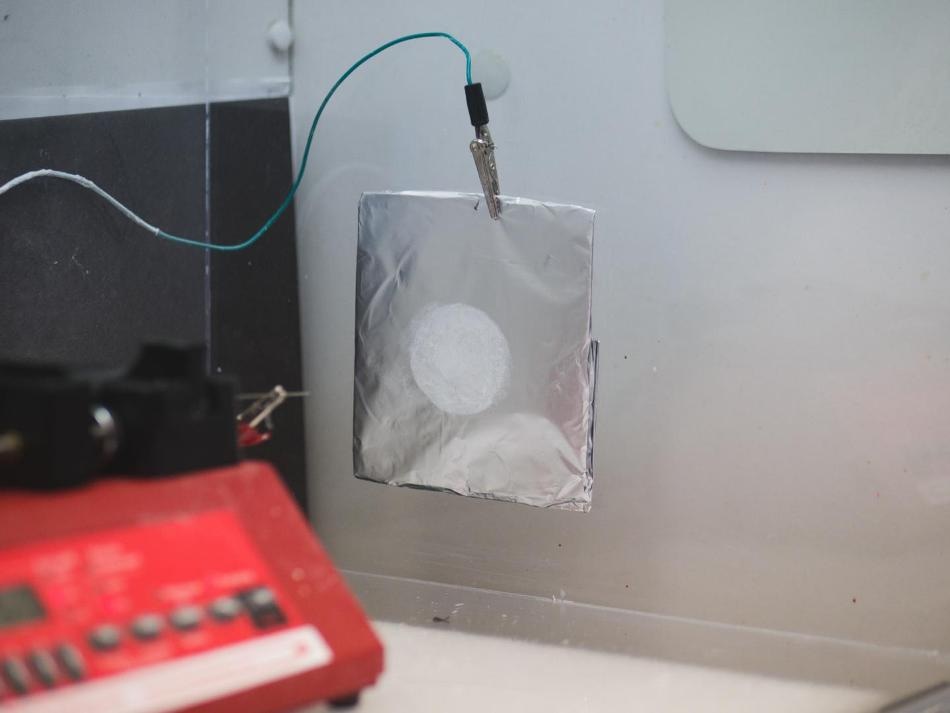Mar 29 2018
In a breakthrough that could result in a new group of materials with functions originally seen only in living systems, researchers at the UC Berkeley have discovered a technique to keep certain proteins active outside of the cell. The researchers used this technology to make mats that can absorb and trap chemical pollution.
 The white fiber mat seen here contains a stable enzyme that can break down a toxic chemical. (Image credit: Christopher DelRe and Charley Huang)
The white fiber mat seen here contains a stable enzyme that can break down a toxic chemical. (Image credit: Christopher DelRe and Charley Huang)
In spite of years of effort to stabilize proteins beyond their native environments, researchers have made very little progress in integrating proteins with synthetic components like fibers without sacrificing protein activity. The latest study reveals a path toward manipulating the power of proteins outside of the cell by demonstrating an innovative way to ensure proteins stay active in synthetic environments. The materials showcased in the study could assist on-demand biochemical reactions, such as in contaminated sites or war zones, where they were once not achievable.
“We think we’ve cracked the code for interfacing natural and synthetic systems,” said study author Ting Xu, a Berkeley professor in the Department of Materials Science and Engineering and the Department of Chemistry, whose lab led the work. The research paper was published on March 16, 2018, in the Science journal.
The issue with proteins is that they are fastidious. Remove them from their innate environments and they will probably fall apart. To function well, proteins must fold into a particular structure, mostly with the help of other proteins. To overcome this hurdle, Xu’s lab examined trends in protein sequences and surfaces to check if they could create a synthetic polymer that offers all the things that a protein would require to maintain its structure and function.
“Proteins have very well-defined statistical pattern, so if you can mimic that pattern, then you can marry the synthetic and natural systems, which allows us to make these materials,” said the study’s first author Brian Panganiban, a former graduate student in Xu’s lab who is currently a chemist at PolyDrop, a Seattle-based chemical company.
The researchers then designed random heteropolymers, which they christened RHPs. RHPs are made up of four types of monomer subunits, each with chemical properties engineered to interact with chemical patches on the surface of proteins of interest. The monomers are connected to imitate a natural protein to exploit the flexibility of their interactions with protein surfaces.
The Northwestern University researchers ran wide-ranging molecular simulations to demonstrate that the RHP would interact positively with protein surfaces, resulting in precise protein folding and stability outside of the cell.
The team then analyzed whether they can use an RHP to develop protein-based materials for bioremediation of poisonous chemicals, which they were funded to accomplish by the Department of Defense. The researchers mixed RHP with a protein known as organophosphorus hydrolase (OPH), which degrades the toxic organophosphates found in chemical warfare agents and insecticides.
The team used the RHP/OPH combination to create fiber mats, submersed the mats in a common insecticide and discovered that the mats degraded an amount of insecticide weighing approximately one-tenth of the total fiber mat within a few minutes. This opens the door to the making of larger mats that could absorb toxic chemicals in areas like war zones.
Their method should be relevant to other enzymes and other materials, Xu said, paving the way for the creation of portable chemistry labs for solving various environmental issues.
The research received grants from the U.S. Department of Defense. Collaborators at Northwestern University were supported by the Department of Energy and the Sherman Fairchild Foundation. Collaborators at the University of Lyon and the Air Force Laboratory received support from the Fulbright program and the Miller Institute.